April 20, 2022
The South Platte River in Deckers – The Lone Rock Campground Run.
Brian releasing a 19" female rainbow. He got it early in the day and it would be the largest fish of the day.
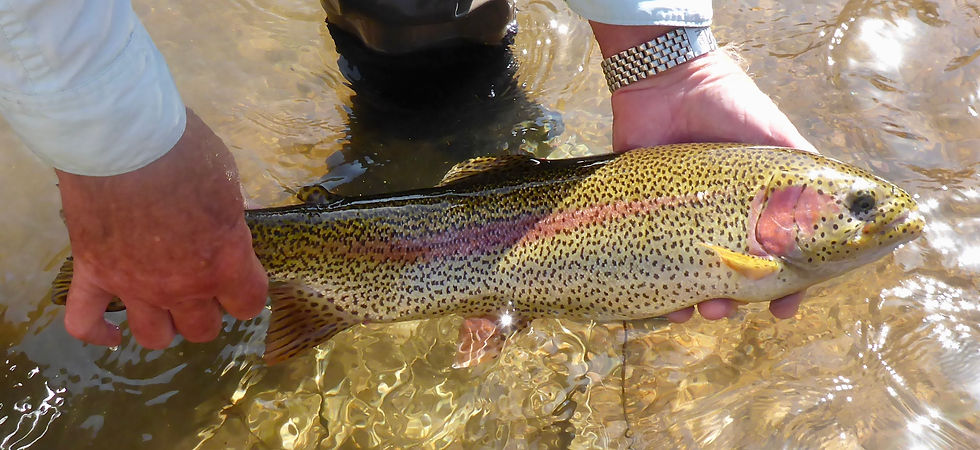
Flows: 258 cfs rising to 340 cfs between 10a and 1p.
Water Temp: 44F @ 8:30a.
Water clarity: Clear – to about 3’.
Air Temp: 43F @ 8:30a – 73F @ 4p.
Hatches: Heavy midge 8:30a to 12N. BWOs 1p to 4p (when we left). Caddis here and there in the afternoon.
Flies: #18 Brown Graphic Caddis, #12 Red San Juan Worm, #22 Mercury Black Beauty, #18 Olive Scud, #24 Grey Mercury RS2, #24 Mercury Baetis, #24 Grey Sparkle Wing RS2, #18 Red Copper John, #18 Hare’s Ear, #20 Red Rainbow Warrior, #20 Bead Head Black Zebra Midge, #22 Black Top Secret Midge, #12 Red Pig Sticker, #20 Black & Grey Flashback RS2, #22 Red Pale Dales Midge, and #22 Top Secret Midge.
Top producers: Graphic Caddis, Scud, Black Zebra Midge, Mercury Baetis, Grey Mercury RS2, Copper John, Pig Sticker, Black & Grey RS2, Pale Dale Midge, Top Secret Midge.
A hungry brownie being released back into the river.
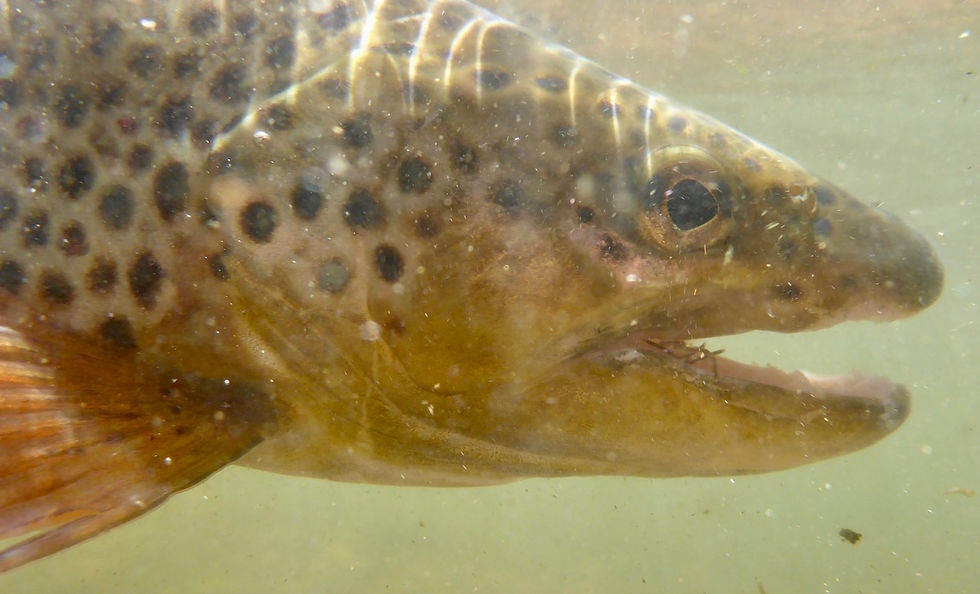
Last week the Lone Rock Campground Run was crazy good. So good that Brian made a solo trip there earlier this week and found that it was still going strong. Until they raised the water level that is. It went up by 50 cfs midday Tuesday – that was enough to turn the water a murky brown and dislodge a bunch of debris. Then the fishing became difficult – at best.
Brian wanted to do it again when we left for the river on Wednesday. Thinking ahead, he even had plans to pay to park in the campground thus saving us the trouble of wading across the river in the elevated flows. I was game for that!
Brian with a the 19" rainbow.

So there we were at the Lone Rock Campground Run - all day! It felt like we were camping out there. I even ate lunch at one of the picnic tables that are set up in the campground. The fishing was both challenging and productive. That’s why we never left. We usually don’t stay in one place all day and it felt a bit strange. We only saw an angler or two peering into the run to see if it was open – and that was in the afternoon. There was no one in sight during the morning.
We didn’t realize it, but the water department again increased the flows late morning – at about 10a. They went up a sizable 80 cfs – but it wasn’t really evident. We didn’t see much debris in the water other than an occasional moss clump. The fish didn’t seem to mind – at least not in this run. We could see them no far off the camp side bank about 10’ to 15’. Some would be closer in in the afternoon - in seams about 2' off shore.
This picture shows the beautiful coloration of a brown trout.

Brian was doing most of the catching in the morning. It seemed every time I looked his way he was either fighting or landing another fish. It was slower for me. I was having a difficult time dialing in the depth and getting my flies in front of the fish. I did land a handful of fish – but it felt like a laborious effort.
We discussed strategy on the drive down – like we normally do. Usually I closely follow the flows in the days before we head out – but this week was hectic and I spaced it. So we were flying blind on that front. The only thing we knew for sure was that the flows were up the day before.
This brownie took Brian's Pig Sticker. It was a hot fly for him in the morning.
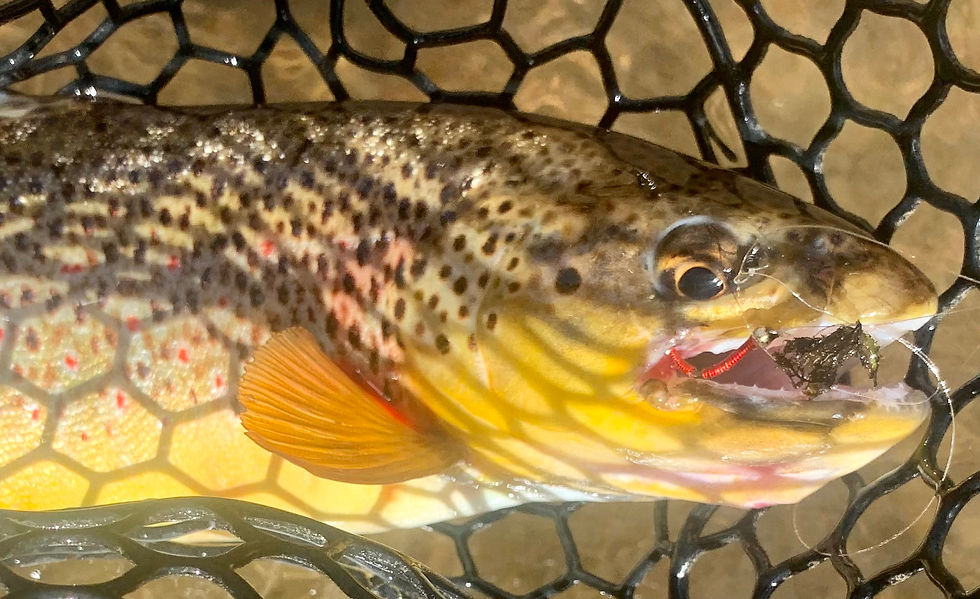
Brian Kenney.
When flows are increased the faster water dislodges flies in their nymphal state. When this happens it’s called “catastrophic drift”. A lot of crane flies, caddis flies, stoneflies, scuds, and other types of aquatic insects get dislodged and the trout feed on them. With this in mind – my plan was to start the day with either a crane fly larva or a stonefly larva as my lead fly. Besides imitating the dislodged insects – they are tied with lead wire and are heavy which helps get your flies down in the faster water. I would then follow either one with a larger (#20) Black Beauty and a UV Scud.
One of my catches. Some of the brownies had a light yellow coloration - more so than usual - on their bellies. Like this one.
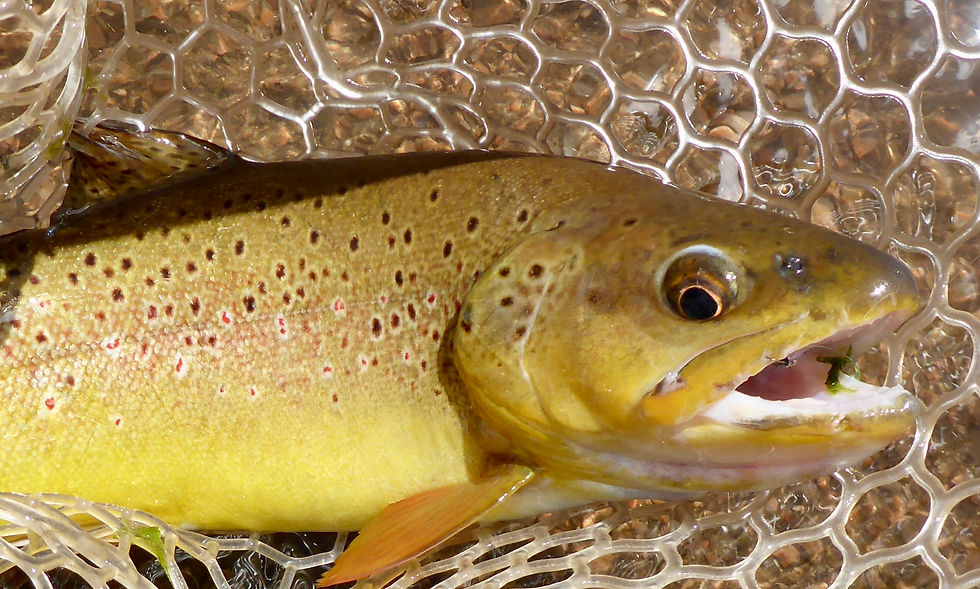
Then when I got to the river I decided to go with a Graphic Caddis as my lead fly and I followed it with a Red San Juan Worm and an Olive UV Scud. I can’t remember why I changed my strategy. This type of setup is not even the way I normally configure my flies. The Graphic Caddis specifically. It is intended to be an emerging caddis and fished as the second or last fly – not the first.
I think this is why I had struggled in the morning. I did get a couple of fish on the Graphic Caddis, even with it misplaced in the fly configuration. But I should have gotten a lot more! It seemed that I was having problems with depth. Continually adding and removing mud trying to get it right. A weighted fly works much better than a lot of split shot or split shot/mud combo. The flies are more natural and they are at the depth that the fish expects them to be.
A female cutbow Brian landed. We would get a handful of these by the end of the day.

Brian Kenney.
It was during lunch that I decided to change my flies and go with the type of fly configuration that I normally do. It seems that I when I do come up with a good idea – it usually coincides with lunch!
After finishing my lunch at one of the picnic tables in the campground and walking to the river, I sat down and retied my nymph rig. I started with a #16 Red Copper John as my lead fly – my attractor. Then I followed it with a Bead Head Black Zebra Midge. I picked this one because the titanium bead would add more weight to my flies. My tail fly was a Mercury Baetis. It imitates a BWO and they were starting to hatch.
A view from the picnic area as I ate lunch.
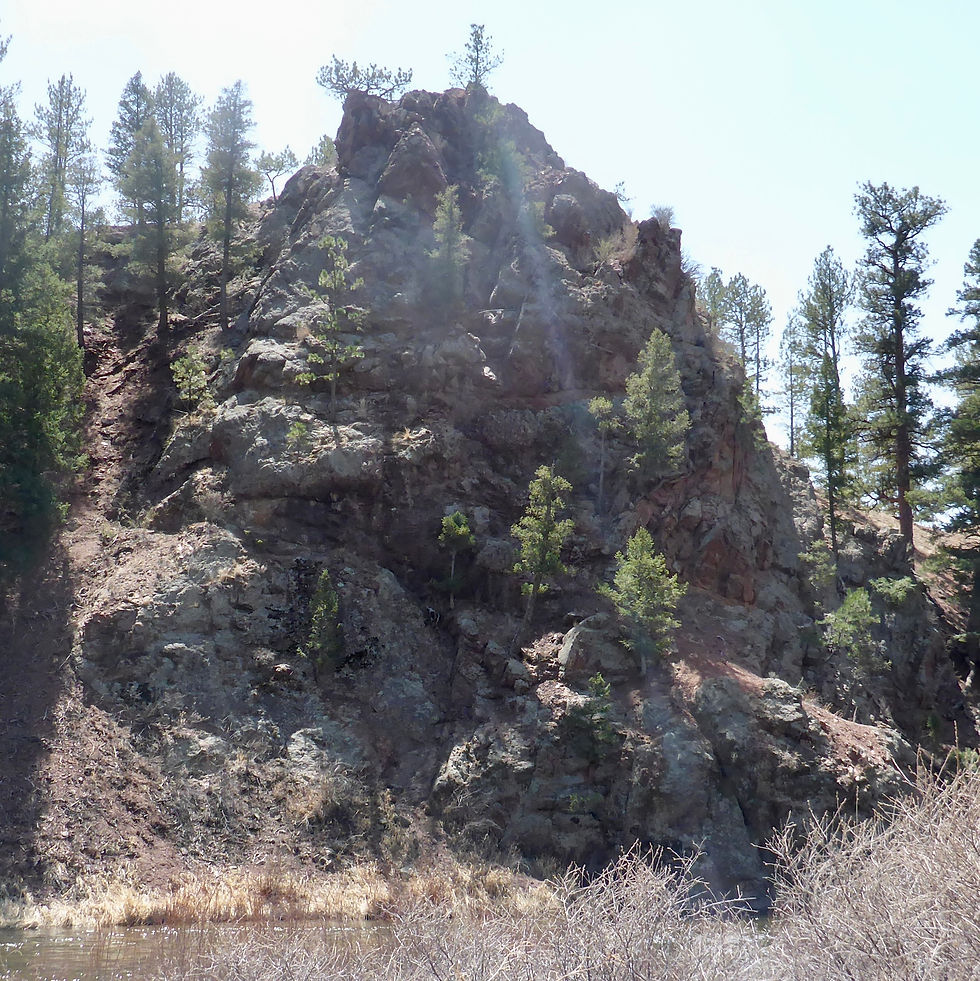
This simple change seemed to have a huge impact on my success. The afternoon was lights out. I mostly fished close to shore. That’s where a lot of fish were congregating and I could see them. It required looking closely in some cases and in others, they were easy to spot.
When I came back from lunch, Brian asked me if it this spot was too easy. My reply was “not really”. In some cases either one of us would get a fish on the first cast to him. In other cases, we would see a fish by couldn’t get him to hit – no matter what we did. Or we would see a fish and it would take considerable effort to get him to take our fly. It was interesting to me – even though sometimes it was a bit frustrating. The interesting part was trying to figure out what the heck was going on with the fish that were reluctant to hit.
This brownie took my Bead Head Black Zebra Midge.
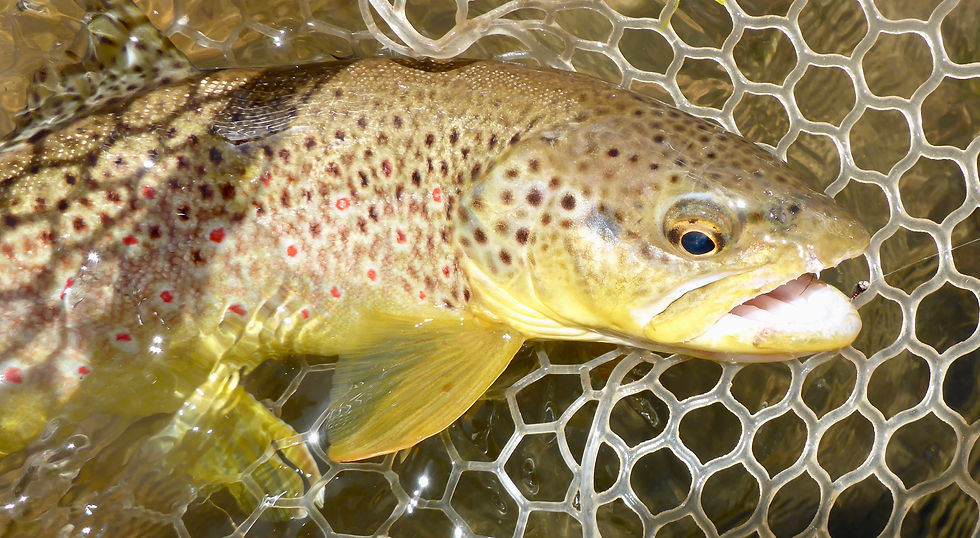
In one case – later in the afternoon – I was casting to a fish that I could see in a deep trough. The fish was sitting behind a clump of something or a rock with moss on it, I couldn’t tell which. Whatever it was provided a bit of shelter from the current but I didn’t think that would be a place for a fish to rest. He had to be eating. After more than several tries and no interest, I began to wonder if it was in fact feeding. Just then the fish came to the surface – head fully out of the water – and ate an adult insect. Then he disappeared. Evidently he was a very picky eater!
What I liked most about our day was that this particular run offers different types of fishing along it. There are shallow troughs along the shore and the fish come into them to feed. There are also pockets along the shore and you will find fish in the pockets behind boulders feeding. Then there are small pools a little farther out – not yet mid-river. In the middle of the river you’ll find waste deep troughs and deeper pockets. At the top of the run there is riffled water and small seams and more pocket water. You may find a single trout in either one of those areas and it feels like you’re fishing a small stream. Finally, there are a couple of deep pools and some slower water where fish rise to adult flies or hunker down in the deeper part.
A cutbow that Brian landed.
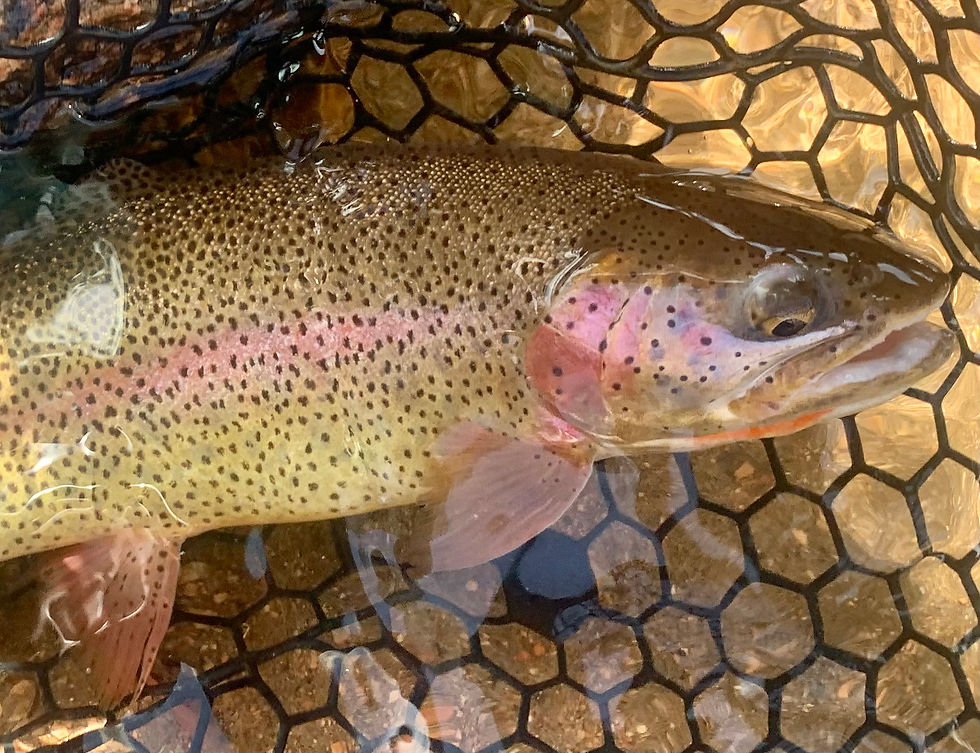
Brian Kenney.
For me the afternoon was all about sight fishing close to shore and RS2s. I got most of my fish within 10’ of shore on a Mercury Baetis and a Grey Mercury RS2. Both of these flies imitate a BWO. The BWO hatch wasn’t as prolific as the last time out – but they were surely in the air and the fish were feeding on the emergers.
After calling it a day, we tried to guess how many fish we had caught between us and agreed it had to be between 30 and 40 fish – more likely closer to 40. It was that kind of day.
This female cutbow had a very weird shape to her lower jaw.

We caught more brown trout than rainbows and most were between 15” and 18”. Brian got the biggest one – a 19”, fat rainbow. It was his second or third fish of the day. All the fish were healthy and fought like crazy – except for Brian’s big rainbow. He said he got a 15 incher that fought harder.
I can attest to that. The last fish I caught was a 15” rainbow. I got her in a small pool of water about 8’ feet from shore. I saw her nymphing in it. She would flash into the upper column then disappear – only to repeat. Definitely feeding on emergers suspended in the upper column. She hit my Grey RS2 and proceeded to take line out as she swam across the river. My first thought was that I must of foul hooked her – but after chasing her across the river and quite a bit downstream I saw that I didn’t. She was just a strong swimmer with a substantial girth – for a 15” rainbow.
One of Brian's brownies.
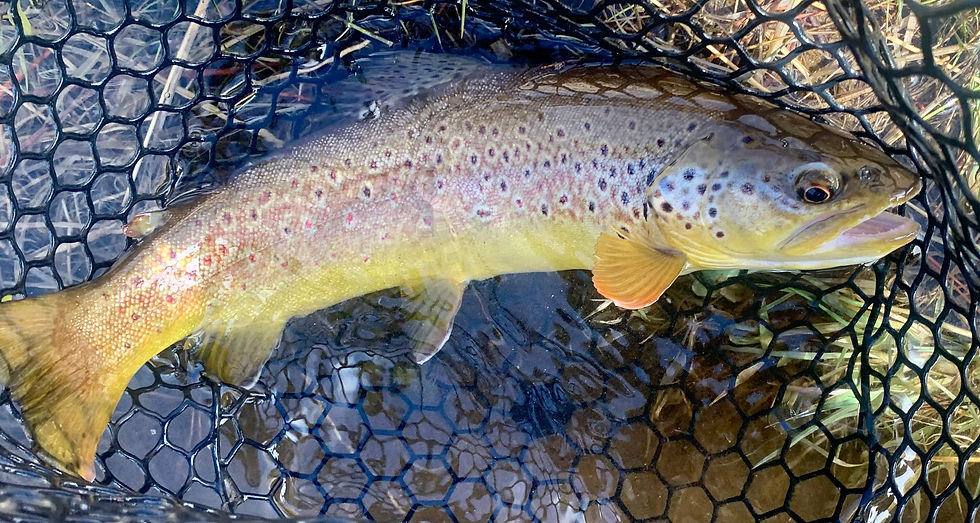
Brian Kenney.
I was totally exhausted when we called it a day. And what a day it was.
Another brownie in the net.
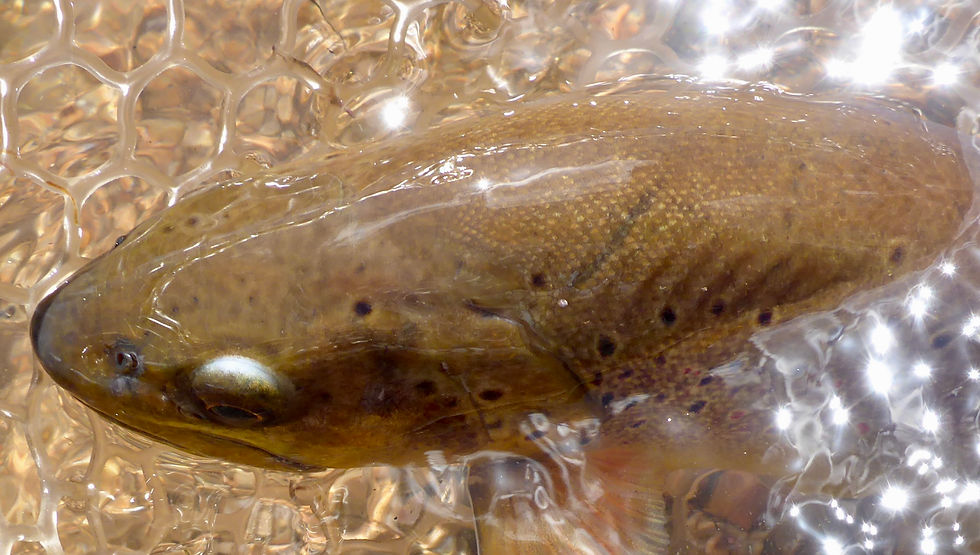
Our camp out was quite a success!
Comments